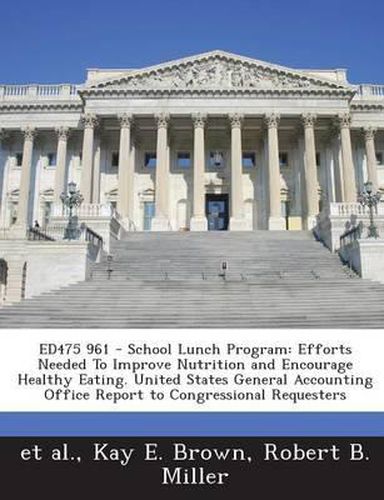Readings Newsletter
Become a Readings Member to make your shopping experience even easier.
Sign in or sign up for free!
You’re not far away from qualifying for FREE standard shipping within Australia
You’ve qualified for FREE standard shipping within Australia
The cart is loading…






Over 15 percent of children are overweight-double the rate in 1980. Children’s diets are high in fat but low in fruits, vegetables, and other nutritious foods. The National School Lunch Program has had a continuing role in providing students with nutritious meals; however students must choose to eat the nutritious food and limit less healthful choices. The U.S. General Accounting Office (GAO) was asked by Congress to report on the extent to which school lunches, nation-wide, were meeting nutrition standards. Among other findings, the GAO found that schools were moving toward meeting school lunch nutrition requirements for nutrients such as protein, vitamins, and minerals, but did not meet the required 30 percent limit for calories from fat. Also efforts to encourage healthy eating could be increased. Students may need more exposure to nutrition education to effect positive changes in their behavior, and most students have access to foods of little nutritional value, such as soft drinks and candy, at school. Barriers to providing nutrition meals and encouraging healthy eating included budget pressures and competing time demands. Schools had taken a variety of innovative steps to overcome barriers, such as modifying recipes to lower the fat content of popular foods, or integrating nutrition lessons into reading and math classes. Based on findings, the GAO recommended that the Secretaries of Agriculture, Health and Human Services, and Education work together to identify specific strategies to help schools promote nutrition education while meeting state academic standards, and to encourage each state to identify a focal point to promote collaborative efforts that would further develop nutrition education activities for schools. (Three appendices include comments from the Department of Health and Human Services and the Department of Education.) (HTH) 7.
$9.00 standard shipping within Australia
FREE standard shipping within Australia for orders over $100.00
Express & International shipping calculated at checkout
Over 15 percent of children are overweight-double the rate in 1980. Children’s diets are high in fat but low in fruits, vegetables, and other nutritious foods. The National School Lunch Program has had a continuing role in providing students with nutritious meals; however students must choose to eat the nutritious food and limit less healthful choices. The U.S. General Accounting Office (GAO) was asked by Congress to report on the extent to which school lunches, nation-wide, were meeting nutrition standards. Among other findings, the GAO found that schools were moving toward meeting school lunch nutrition requirements for nutrients such as protein, vitamins, and minerals, but did not meet the required 30 percent limit for calories from fat. Also efforts to encourage healthy eating could be increased. Students may need more exposure to nutrition education to effect positive changes in their behavior, and most students have access to foods of little nutritional value, such as soft drinks and candy, at school. Barriers to providing nutrition meals and encouraging healthy eating included budget pressures and competing time demands. Schools had taken a variety of innovative steps to overcome barriers, such as modifying recipes to lower the fat content of popular foods, or integrating nutrition lessons into reading and math classes. Based on findings, the GAO recommended that the Secretaries of Agriculture, Health and Human Services, and Education work together to identify specific strategies to help schools promote nutrition education while meeting state academic standards, and to encourage each state to identify a focal point to promote collaborative efforts that would further develop nutrition education activities for schools. (Three appendices include comments from the Department of Health and Human Services and the Department of Education.) (HTH) 7.